
That is reasonably close to your setup, I think, so I was optimistic. I have an Intel i7-13700K on an ASRock motherboard. But I'm not sure what setting changed that. I've changed a lot of settings and don't see that anymore. I used to see the Windows machine through the video card but using the Windows driver (and seeing only a portion of the screen. I'd set that to embedded, but changed it to auto, to see what would happen.

The choices are embedded, PCI slot and auto. Your solution in BIOS prompted me to change my BIOS primary display setting. I've tried adding them in the vfio-pci options, but that doesn't change their drivers, so I've taken them back out. I also have two devices identified as AMD but are PCI bridges, 1002:14:1479. I have two, 1002:743f and 1002:ab28, which are close to yours. No, I used my own device IDs and the "lspci nnk" command shows "Kernel driver in use: vfio-pci". Enabled SRIOV in BIOS (tried iGPU passthrough but failed, Alder Lake CPU).Blacklisted video drivers: amdgpu, radeon.vfio_iommu_type1 allow_unsafe_interrupts=1.Kernel modules loaded: vfio, vfio_iommu_type1, vfio_pci, vfio_virqfd.Grub command line, added: intel_iommu=on iommu=pt initcall_blacklist=sysfb_init.Different driver installations, driver only, minimal, full install.Enable GPU rendering over RDP in group edit.Connect the card to a monitor because some posts say it can't be unplugged.

I can confirm graphic acceleration is not working because I only get single digit FPS in this WebGL test (not the best benchmark I know : ) ). The GPU is detected by Windows, AMD driver installation appears to be successful, no errors whatsoever but for some reason the GPU still has that small exclamation mark in device manager. I followed this guide loosely, everything worked till the last step.


 0 kommentar(er)
0 kommentar(er)
